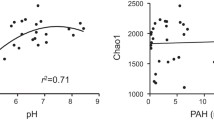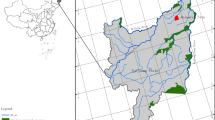Abstract
Purpose
Thaumarchaeota is an ecologically relevant archaeal phylum which may significantly contribute to global nitrogen cycling. Thaumarchaeotal abundance, composition, and activity can be changed by soil pH and pollutants such as toxic metals. This study aims to examine the responses of thaumarchaeotal community to soil pH variation and polycyclic aromatic hydrocarbon (PAH) pollution which may co-occur in agricultural soils.
Materials and methods
Field soil samples were collected from agricultural land impacted by both acidification and PAH contamination. Thaumarchaeotal abundance and composition were assessed using molecular approaches targeting 16S rRNA or amoA genes and were linked to environmental factors by correlation and canonical correspondence analysis (CCA). To evaluate the short-term responses of Thaumarchaeota to PAHs, additional soil microcosms amended with either three selected PAHs were established. Changes in thaumarchaeotal communities during the incubation were monitored.
Results and discussion
A significant correlation between thaumarchaeotal gene abundance and soil pH was observed within field samples, with the I.1a-associated group enriched when pH <5.0. CCA suggests that the community variation was primarily related to soil pH. In contrast, the effects of PAHs were minimal. In soil microcosms, high concentrations of PAHs persisted after the 4-week incubation. Independent of the PAHs added, thaumarchaeotal amoA abundance slightly increased and the compositions were stable at the end of the incubation. This might be associated with the pollutants bioavailability and potential microbe-PAH interactions in the soil.
Conclusions
Soil pH variation strongly shapes the agricultural soil thaumarchaeotal community, whereas PAH effects appear to be marginal even in the presence of high concentrations of pollutants. The complicated interaction between soil matrix, pollutants, and Thaumarchaeota requires further study.





Similar content being viewed by others
References
Alexander M (2000) Aging, bioavailability, and overestimation of risk from environmental pollutants. Environ Sci Technol 34:4259–4265
Brochier-Armanet C, Boussau B, Gribaldo S, Forterre P (2008) Mesophilic crenarchaeota: proposal for a third archaeal phylum, the Thaumarchaeota. Nat Rev Microbiol 6:245–252
Chang S, Hyman M, Williamson K (2002) Cooxidation of naphthalene and other polycyclic aromatic hydrocarbons by the nitrifying bacterium, Nitrosomonas europaea. Biodegradation 13:373–381
de Menezes A, Clipson N, Doyle E (2012) Comparative metatranscriptomics reveals widespread community responses during phenanthrene degradation in soil. Environ Microbiol 14:2577–2588
Großkopf R, Janssen PH, Liesack W (1998) Diversity and structure of the methanogenic community in anoxic rice paddy soil microcosms as examined by cultivation and direct 16S rRNA gene sequence retrieval. Appl Environ Microbiol 64:960–969
Gubry-Rangin C, Hai B, Quince C, Engel M, Thomson BC, James P, Schloter M, Griffiths RI, Prosser JI, Nicol GW (2011) Niche specialization of terrestrial archaeal ammonia oxidizers. Proc Natl Acad Sci 108:21206–21211
Guo JH, Liu XJ, Zhang Y, Shen JL, Han WX, Zhang WF, Christie P, Goulding KWT, Vitousek PM, Zhang FS (2010) Significant acidification in major Chinese croplands. Science 327:1008–1010
Harvey RG (1991) Polycyclic aromatic hydrocarbons: chemistry and carcinogenicity. Cambridge University Press, Cambridge
He J-Z, Hu H-W, Zhang L-M (2012) Current insights into the autotrophic thaumarchaeal ammonia oxidation in acidic soils. Soil Biol Biochem 55:146–154
Huber T, Faulkner G, Hugenholtz P (2004) Bellerophon: a program to detect chimeric sequences in multiple sequence alignments. Bioinformatics 20:2317–2319
Juhasz AL, Naidu R (2000) Bioremediation of high molecular weight polycyclic aromatic hydrocarbons: a review of the microbial degradation of benzo[a]pyrene. Int Biodeter Biodegrad 45:57–88
Könneke M, Bernhard AE, de la Torre JR, Walker CB, Waterbury JB, Stahl DA (2005) Isolation of an autotrophic ammonia-oxidizing marine archaeon. Nature 437:543–546
Lehtovirta-Morley LE, Stoecker K, Vilcinskas A, Prosser JI, Nicol GW (2011) Cultivation of an obligate acidophilic ammonia oxidizer from a nitrifying acid soil. Proc Natl Acad Sci 108:15892–15897
Liu Y-R, Zheng Y-M, Shen J-P, Zhang L-M, He J-Z (2010) Effects of mercury on the activity and community composition of soil ammonia oxidizers. Environ Sci Pollut Res 17:1237–1244
Lu R (2000) Analytical methods for soil and agrochemistry. China Agricultural Science and Technology Press, Beijing
Mertens J, Broos K, Wakelin SA, Kowalchuk GA, Springael D, Smolders E (2009) Bacteria, not archaea, restore nitrification in a zinc-contaminated soil. ISME J 3:916–923
Mertens J, Wakelin SA, Broos K, McLaughlin MJ, Smolders E (2010) Extent of copper tolerance and consequences for functional stability of the ammonia-oxidizing community in long-term copper-contaminated soils. Environ Toxicol Chem 29:27–37
Nicol GW, Leininger S, Schleper C, Prosser JI (2008) The influence of soil pH on the diversity, abundance and transcriptional activity of ammonia oxidizing archaea and bacteria. Environ Microbiol 10:2966–2978
Ochsenreiter T, Selezi D, Quaiser A, Bonch-Osmolovskaya L, Schleper C (2003) Diversity and abundance of Crenarchaeota in terrestrial habitats studied by 16S RNA surveys and real time PCR. Environ Microbiol 5:787–797
Oton EV, Quince C, Nicol GW, Prosser JI, Gubry-Rangin C (2016) Phylogenetic congruence and ecological coherence in terrestrial Thaumarchaeota. ISME J 10:85–96
Pester M, Schleper C, Wagner M (2011) The Thaumarchaeota: an emerging view of their phylogeny and ecophysiology. Curr Opin Microbiol 14:300–306
Pester M, Rattei T, Flechl S, Gröngröft A, Richter A, Overmann J, Reinhold-Hurek B, Loy A, Wagner M (2012) amoA-based consensus phylogeny of ammonia-oxidizing archaea and deep sequencing of amoA genes from soils of four different geographic regions. Environ Microbiol 14:525–539
Ping LF, Luo YM, Zhang HB, Li QB, Wu LH (2007) Distribution of polycyclic aromatic hydrocarbons in thirty typical soil profiles in the Yangtze River Delta region, east China. Environ Pollut 147:358–365
Prosser JI, Nicol GW (2008) Relative contributions of archaea and bacteria to aerobic ammonia oxidation in the environment. Environ Microbiol 10:2931–2941
Prosser JI, Nicol GW (2012) Archaeal and bacterial ammonia-oxidisers in soil: the quest for niche specialisation and differentiation. Trends Microbiol 20:523–531
Rotthauwe J, Witzel K, Liesack W (1997) The ammonia monooxygenase structural gene amoA as a functional marker: molecular fine-scale analysis of natural ammonia-oxidizing populations. Appl Environ Microbiol 63:4704–4712
Schloss PD, Westcott SL, Ryabin T, Hall JR, Hartmann M, Hollister EB, Lesniewski RA, Oakley BB, Parks DH, Robinson CJ, Sahl JW, Stres B, Thallinger GG, Van Horn DJ, Weber CF (2009) Introducing mothur: open-source, platform-independent, community-supported software for describing and comparing microbial communities. Appl Environ Microbiol 75:7537–7541
Shen J-P, Xu Z, He J-Z (2014) Frontiers in the microbial processes of ammonia oxidation in soils and sediments. J Soils Sediments 14:1023–1029
Sipos AJ, Urakawa H (2016) Differential responses of nitrifying archaea and bacteria to methylene blue toxicity. Lett Appl Microbiol 62:199–206
Subrahmanyam G, Hu H-W, Zheng Y-M, Gattupalli A, He J-Z, Liu Y-R (2014a) Response of ammonia oxidizing microbes to the stresses of arsenic and copper in two acidic alfisols. Appl Soil Ecol 77:59–67
Subrahmanyam G, Shen J-P, Liu Y-R, Archana G, He J-Z (2014b) Response of ammonia-oxidizing archaea and bacteria to long-term industrial effluent-polluted soils, Gujarat, Western India. Environ Monit Assess 186:4037–4050
Sverdrup LE, Hagen SB, Krogh PH, van Gestel CAM (2007) Benzo(a)pyrene shows low toxicity to three species of terrestrial plants, two soil invertebrates, and soil-nitrifying bacteria. Ecotoxicol Environ Saf 66:362–368
Tamura K, Dudley J, Nei M, Kumar S (2007) MEGA4: molecular evolutionary genetics analysis (MEGA) software version 4.0. Mol Biol Evol 24:1596–1599
ter Braak CJF, Šmilauer P (2002) CANOCO reference manual and CanoDraw for Windows user’s guide. Wageningen, Biometris
Tourna M, Stieglmeier M, Spang A, Könneke M, Schintlmeister A, Urich T, Engel M, Schloter M, Wagner M, Richter A, Schleper C (2011) Nitrososphaera viennensis, an ammonia oxidizing archaeon from soil. Proc Natl Acad Sci 108:8420–8425
Urakawa H, Garcia JC, Barreto PD, Molina GA, Barreto JC (2012) A sensitive crude oil bioassay indicates that oil spills potentially induce a change of major nitrifying prokaryotes from the Archaea to the bacteria. Environ Pollut 164:42–45
Weber EB, Lehtovirta-Morley LE, Prosser JI, Gubry-Rangin C (2015) Ammonia oxidation is not required for growth of group 1.1c soil Thaumarchaeota. FEMS Microbiol Ecol. doi:10.1093/femsec/fiv001
Wu Y, Conrad R (2014) Ammonia oxidation-dependent growth of group I.1b Thaumarchaeota in acidic red soil microcosms. FEMS Microbiol Ecol 89:127–134
Wu Y, Luo Y, Zou D, Ni J, Liu W, Teng Y, Li Z (2008) Bioremediation of polycyclic aromatic hydrocarbons contaminated soil with Monilinia sp.: degradation and microbial community analysis. Biodegradation 19:247–257
Wu Y, Lu L, Wang B, Lin X, Zhu J, Cai Z, Yan X, Jia Z (2011) Long-term field fertilization significantly alters community structure of ammonia-oxidizing bacteria rather than archaea in a paddy soil. Soil Sci Soc Am J 75:1431–1439
Xu SS, Liu WX, Tao S (2006) Emission of polycyclic aromatic hydrocarbons in China. Environ Sci Technol 40:702–708
Yao H, Gao Y, Nicol GW, Campbell CD, Prosser JI, Zhang L, Han W, Singh BK (2011) Links between ammonia oxidizer community structure, abundance, and nitrification potential in acidic soils. Appl Environ Microbiol 77:4618–4625
Zeng J, Lin X, Zhang J, Zhu H, Chen H, Wong M (2013) Successive transformation of benzo[a]pyrene by laccase of Trametes versicolor and pyrene-degrading Mycobacterium strains. Appl Microbiol Biotechnol 97:3183–3194
Zhalnina K, de Quadros PD, Gano KA, Davis-Richardson A, Fagen JR, Brown CT, Giongo A, Drew JC, Sayavedra-Soto LA, Arp DJ, Camargo FAO, Daroub SH, Clark IM, McGrath SP, Hirsch PR, Triplett EW (2013) Ca. Nitrososphaera and Bradyrhizobium are inversely correlated and related to agricultural practices in long-term field experiments. Front Microbiol 4:104
Zhang L-M, Hu H-W, Shen J-P, He J-Z (2012) Ammonia-oxidizing archaea have more important role than ammonia-oxidizing bacteria in ammonia oxidation of strongly acidic soils. ISME J 6:1032–1045
Acknowledgments
We thank Dr. Junli Hu for his helpful suggestions to the manuscript. This study was supported by the 973 Program of Ministry of Science and Technology of China (2014CB441106), the National Natural Science Foundation of China (41371310, 41201301), and the Natural Science Foundation of Jiangsu Province (BK20131462). Y. Wu acknowledges the fellowships from the Youth Innovation Promotion Association, Chinese Academy of Sciences and the State Key Laboratory of Soil and Sustainable Agriculture (Y212000014).
Author information
Authors and Affiliations
Corresponding author
Additional information
Responsible editor: Jizheng He
Electronic supplementary material
Below is the link to the electronic supplementary material.
ESM. 1
(DOCX 136 kb)
Rights and permissions
About this article
Cite this article
Wu, Y., Zhu, Q., Zeng, J. et al. Effects of pH and polycyclic aromatic hydrocarbon pollution on thaumarchaeotal community in agricultural soils. J Soils Sediments 16, 1960–1969 (2016). https://doi.org/10.1007/s11368-016-1390-9
Received:
Accepted:
Published:
Issue Date:
DOI: https://doi.org/10.1007/s11368-016-1390-9




